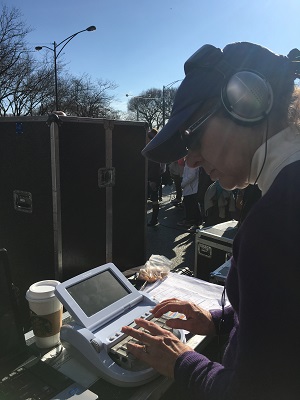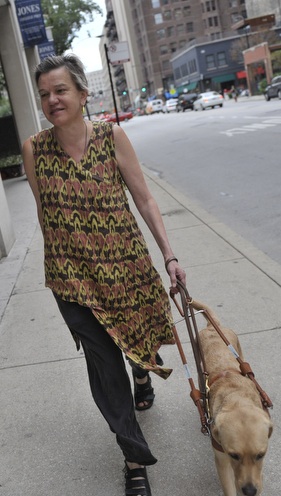At last! News everyone can be happy about: retired Seeing Eye dog celebrates 17th birthday today
February 8, 2017 • 20 Comments • Posted in blindness, guide dogs, Seeing Eye dogs, UncategorizedHanni’s still spry at 17!
Bring out the party hats! Hanni turns 17 years old today. You read that right: seventeen.
Loyal dog followers know that after Hanni retired from guide work, she went to live with our dear friends Nancy and Steven. They started celebrating the big day last Sunday with a visit to nearby Homer Lake–Nancy sends audio messages to my iPhone whenever they head to that forest preserve. The audio reports are a joy to hear — they always come with background sound of Hanni panting after a run or chomping on well-deserved treats. “We’re getting ready for Hanni’s big 17th on Wednesday,” Nancy said in Sunday’s audio report. “It’s a beautiful day, sunny, the geese are out, hard to believe it’s February.”
I guess it should be hard to believe that a 17-year-old Labrador and Golden Retriever Cross can still get out and enjoy a romp at a forest preserve, but I’ve gotten used to it. My first Seeing Eye dog Dora retired at 12 and lived to be 17 years old, and my third dog, Harper, who retired after saving us from getting hit by a car in Chicago traffic, is healthy and robust at age 8. The excellent health of these mature dogs has everything to do with the wonderful friends who adopt my retired dogs, but the care and research the Seeing Eye and other guide dog schools put into their breeding programs deserves a lot of credit, too.
Some schools still train service dogs who’ve been donated from individuals or from animal shelters, but the more established guide dog schools breed their own dogs in order to end up with the unique traits so important to guide work:
- excellent health
- intelligence
- temperament
- willingness to work
- ability to thrive on praise
The Seeing Eye breeds Labrador retrievers, golden retrievers, Lab/golden crosses and German Shepherds. Decades of research has gone into the Seeing Eye’s breeding program, much of it driven by the fact there is no “perfect Seeing Eye dog.” Dogs of all sorts of temperament, size, strength, speed and energy are necessary to match with blind people who come to the Seeing Eye school with, guess what, all sorts of temperament, size, strength, speed and energy levels. The Seeing Eye web site says their breeding station has “interconnected geometric pavilions, designed so that dogs can see each other and see people enter the kennel, so barking–not to mention stress – are greatly reduced.” Their goal? “To provide a facility most conducive to a positive early childhood experience for the puppies.” I just love that.
And I just love Hanni, too. I’m so grateful the Seeing Eye bred her for me, and so happy to think of her celebrating with Nancy and Steven today. Happy birthday, dear Hanni. Happy birthday to you.





